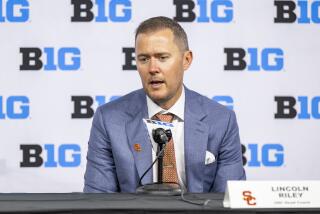ANALYSIS : Southwest Conference Fades Into Sunset--Is This So Bad?
- Share via
HOUSTON — Like the coupe convertible with running boards on the side, the wide-brimmed fedora and the big red-and-white sign saying “Drink Coca-Cola in bottles,” the Southwest Conference had its day.
It’s done now--a victim of the need to chase down big television contracts, forge alliances with major bowls and compete with the other superconferences.
The Big Eight is adding Texas, Texas A&M;, Texas Tech and Baylor, making it the Big 12, and what’s left of the Southwest Conference will be the Little Four--Rice, Texas Christian, Houston and Southern Methodist.
The first instinct is to decry the breakup of the SWC, a Texas tradition dating to 1915.
The intrastate rivalries of the eight Texas schools have been lost because they all aren’t fighting for the same goal: the host berth in the Cotton Bowl.
The Little Four have been set adrift in a new age that demands marketability. That means winning, going to bowl games, putting fans in the stands.
But wait. Is this so bad?
The SWC does have a glorious past, filled with tradition and names like Doak Walker, Earl Campbell, Darrell Royal and Bear Bryant; offenses like the wishbone and run-and-shoot.
Traditionalists would prefer to have a little conference neatly confined inside Texas, fighting each other on the playing field but banded together against the outsiders who want to recruit the state’s best players.
It worked, sort of, for almost a century. It doesn’t work at all any more.
Houston will always be a commuter school; Rice will always have a tiny alumni base; Southern Methodist may never overcome the effects of the death penalty; Texas Christian and the other Little Four will always be fighting the shadow of the pros.
Also, unless something has been left out of the news, the four departing schools won’t move their campuses to Kansas. They’ll still be in Texas. They’ll still be playing each other, and possibly the Little Four.
Earl Campbell still played for the Longhorns. The legend of the Aggies’ 12th Man won’t suddenly disappear. It’s all still in place. It’s just going to be different.
It will take awhile for everyone to get accustomed to the new order.
Several state officials, including those from Houston, have threatened to make the deserters pay for splitting up the SWC.
But the four departing schools made a politically correct maneuver. They have alumni in high places if there is any legislative heat.
Texas A&M; and Texas have strong enough representation to form a protective coalition. Gov. Ann Richards and Lt. Gov. Bob Bullock are Baylor graduates. State Rep. Rob Junell, chairman of the Texas House Appropriations committee and Texas House Speaker Pete Laney are Texas Tech graduates.
Harris County legislators are especially concerned about the effect on Houston to have Rice and Houston left out of the changes.
“I’m for UH getting its due,” said Rep. Debra Danburg, a Houston alumna. “If that means taking it out of the hides of the University of Texas and Texas A&M;, I’ll be glad to do it.”
What will happen to the Little Four?
Maybe they’ll take the attitude of Houston football coach Kim Helton, who will soon have a $25 million sports complex to promote. He doesn’t sound like a man ready to quit.
“We intend to win the national championship,” Helton said. “We are headed in a very positive direction and to exclude Houston from where its headed would be a mistake on their part.”
The message is no longer subliminal. Long discussed changes are here and mourning the passing of the SWC won’t cause Dallas Cowboys fans to tear up their season tickets to go watch the Mustangs in Ownby Stadium.
The sooner the states’ fans realize it’s a changing world out there, some of the pain may begin to subside.
More to Read
Go beyond the scoreboard
Get the latest on L.A.'s teams in the daily Sports Report newsletter.
You may occasionally receive promotional content from the Los Angeles Times.









